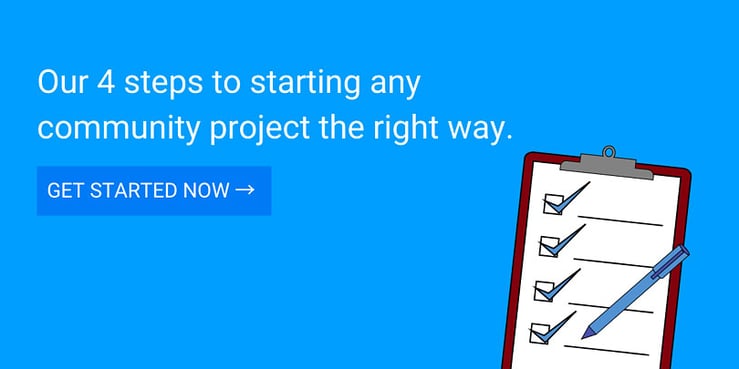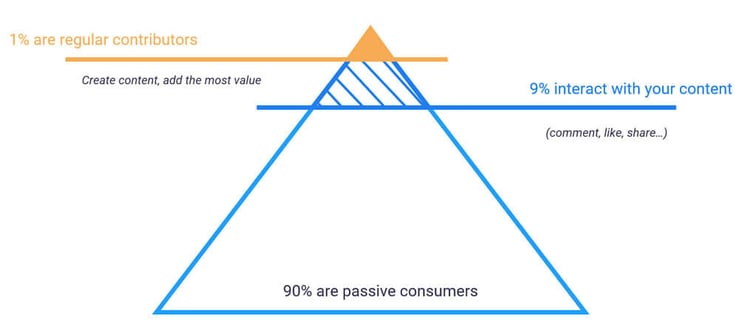
5 years ago, our team launched its first community platform. Since then we’ve built online communities with some of the world’s biggest brands.
As we grow, I want to start sharing our key learnings for community building. In short, bring you “The Complete Guide to Building Brand Communities” we think is missing today.
This guide will include actionable info on how community can:
- boost customer loyalty and word-of-mouth
- help you understand who your customer is and what they want
- turn your best customers into key resources for your business
Let’s dig in.
Or click here to jump to a specific section:
- Why are you building a customer community?
- Who are you building this community for?
- Where should you build this community?
- How can you build your customer community?
1. WHY ARE YOU BUILDING A CUSTOMER COMMUNITY?
Your “why”: setting a clear business goal
Everything else you do will depend on this.
Community goals are usually similar depending on the industry you’re in:
- Cosmetics brands crowd-source products or leverage their community to generate non-stop quality reviews.
See Glossier for a great example on this
- Fashion brands leverage fans on social media. They repost customer generated photos and/or display the photos on product pages.
- Niche Retailers leverage knowledgeable customers to help other visitors on their website. This lowers friction and customer support cost.
Superdrug's online beauty community helps 10,000 customers/month.
This doesn’t mean you should be chasing reviews if you’re a beauty brand. We’ve seen marketers approach community from all angles. What matters is that there are clear business objectives to justify your community-building effort.
Your community’s "Daily Goal”: giving your community something real to chew on
In recent years, I’ve seen many companies launch communities that didn’t stick. People weren’t coming back. To me, the biggest problem with these was that the goal of the community was for people to just talk to each other.
This rarely works. At TokyWoky, there’s something we call the daily goal. And it’s one of the key points we’ve worked on in community building.
If you want top customers to contribute to your community, they’re going to need something to chew on. A daily goal comes down to building something that gives people a reason to come back every day.
- One way we do this at TokyWoky, is integrate a community chat on most of our community platforms. This is where ambassadors answer non-stop questions from other visitors, giving them plenty to do and a sense of purpose.
The daily goal can take other shapes as well (give product-feedback, share tips…), but it all comes down to the same idea:
Communities don’t die because they have too much to do; they die because they have too little to do.
For a similar take on this, I recommend Guy Kawasaki’s the Art of Creating a Community if you haven’t read it already.
WHO ARE YOU BUILDING THIS COMMUNITY FOR?
Decide who to target
Deciding who you’ll target depends on the goal you set earlier in the article.
- If your goal is to attract new customers and increase brand recognition, we’d focus on customers who are active on social media.
- If you want to add live help and/or a forum-type community, we recommend finding experts who will give their time to answer questions.
We’ll cover how to do this a little later in this blog post.
Focus on the 1% to build a strong community
Here’s one of the biggest lessons I learned: the 1% rule is key in community building, just like it is on social media.

We see this with brands we work with on the community chat - a few hundred people answer 10,000s of questions per month.
Another huge learning then:
Don’t measure community success by its size (or other vanity metrics) but on the value it creates.
Focus on the 1% that creates the most value.
Your top 1% are not only your most engaged audience and potential brand advocates, they’re often also your top customers.
Brands should focus their energy on these fans instead of trying to appeal to people that only casually like/know their brand. It’s a more direct way to build loyalty, get word-of-mouth going, and create a unique brand people will relate to.
Read more about this from Seth Godin, and why he once turned down Oprah.
Don’t limit yourself to your customers only
When you build your community, don't just focus on your top customers. Your team is one of your best assets. After all, they know your brand, who you are and what you sell.
If you’re a physical retailer, leveraging your in-store associates is a clear best-practice. Other great community examples we’ve seen and/or worked on also leverage their in-house team.
They can have an admin role but can also become active contributors or community managers.
We’ll share more about this in future articles. But if you’re working on a community project now, we’d advise to try and see how you can fit your team into it!
WHERE SHOULD YOU BUILD THIS COMMUNITY?
Social media won’t fully leverage your top ambassadors
Social media is a powerful tool and a key customer support channel. But it’s not the right fit for your 1% most valuable ambassadors:
- You can lose access when the rules change. See Facebook’s push on groups: brands are forced to increase their ad-spending to reach an audience they spent years building.
- You’re limited in what you can do. Socials are ultimately a communication tool. Co-creation, shopper-to-shopper help, product testing… many features we regularly work on with community can’t be done at scale on social media.
Use your current traffic on your e-commerce website
The e-commerce website is the most strategic place for a brand or retailer to build a community.
You’ve been growing your website traffic for years and visitors are ready to buy. No need to start from scratch attracting visitors to an external community website. If you build it onsite, your community is readily available to all your shoppers.
Additionally, ambassadors are engaged closer to the buying decision than on social media. Any content they create or help they offer will have direct impact on conversion.
HOW DO YOU BUILD YOUR COMMUNITY?
Automatically give your community something to do
Automating is key here.
We see brands shelve community projects once they feel it will become too resource intensive. In other words, that they’ll spend too much time and resources creating content to “feed” their community.
ROI would be harder to achieve. And once they stop feeding continuous content, the community fails because there’s not enough to do. That’s why it’s vital to automate this part of your community.
One way we do this in a way that scales is through live chat. There will always be people on your website asking questions. Ambassadors will always have something to do.
From onboarding to long-term retention
At TokyWoky, we rely on 3 pillars:
1. Gamification for onboarding
Badges, unlocking new features… this is key to incentivise new ambassadors to fully explore the community. Key steps are celebrated: upon joining, first message, first time helping someone, first reaction…
2. Social recognition for setting a community culture
After onboarding, you need to switch to rewarding the people who create the most value. We often do this with “experience points”. These are only awarded by other community members when someone is being helpful or has an interesting contribution.
Quality should always win over quantity. This is especially important if you link your community to a loyalty program. Your community culture will depend on the balance you find between gamification and social recognition.
3. Peer-to-peer interactions for long-term retention
When we polled 2000 ambassadors on their #1 reason to log on: “talking to my friends” came first.
This is because gamification becomes less impactful when someone’s been active for a while. If you want your top ambassadors to stay, build a community where people can meet and talk to each other daily.
Reward community members with unique experiences
The question every community manager faces: (how) do we reward brand ambassadors?
It’s a tricky part that you need to get right if you want to set the right tone for your community. And it will mostly depend on your brand and values.
We recommend you don’t present rewards as such. Rather, these are “perks” that come with the experience an ambassador can earn by contributing to the community.
You can send samples to your top beauty experts because their input will be the most valuable, giving top fashion ambassadors a sneak peek of the new collection. If you have a physical store, that’s an advantage. You can invite top ambassadors to the opening of new stores or ambassador days.
We’ve found that the best way to retain your 1% top ambassadors is by offering unique experiences they wouldn’t get through other channels (social, email campaigns…).
You're all set to start your community project!
Found this helpful? Ask questions or request your community workshop here.



.jpg?width=800&name=Get%20the%20Community%20playbook%20(1).jpg)

.png)
